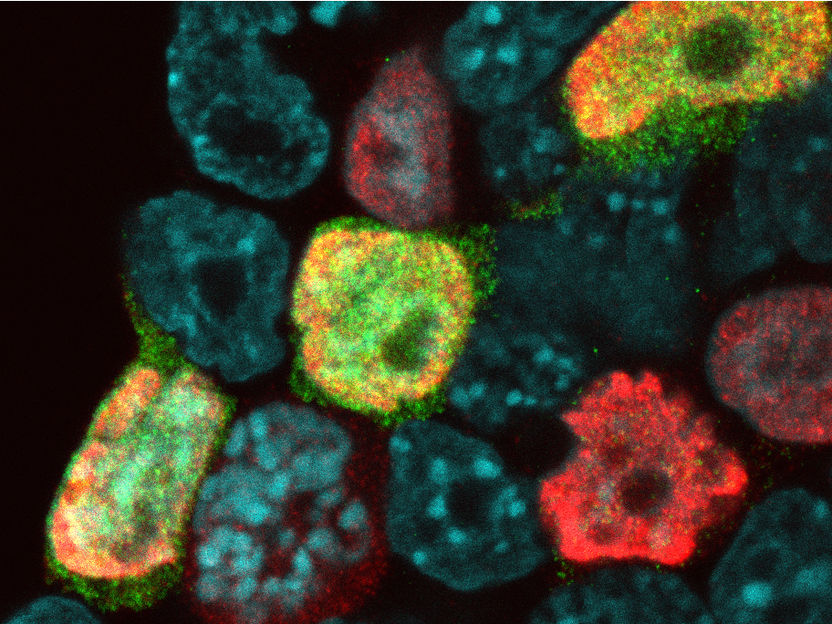(Re)-acquiring the potential to become everything
Advertisement
A new study identifies a specific population of pluripotent embryonic stem cells that can reprogram to totipotent-like cells in culture. Moreover, the scientists of Helmholtz Zentrum München and Ludwig-Maximilians-Universität München (LMU) have identified bottlenecks and drivers of this reprogramming.

Fluorescence image of mouse embryonic stem cells (nuclei in blue) including 2 cell-like cells (green) and the novel population of transitioning cells (red).
Helmholtz Zentrum München/IES
Cellular plasticity is the ability of a cell to make different cell types. At the early stages of life, the fertilized single-cell coming from the mother’s egg and the father’s sperm is highly plastic - it will give rise to all of the cell types of the body. Cellular plasticity is therefore essential for multicellular organisms like humans to exist.
The single fertilized cell first divides into two cells (referred to as the 2-cell stage of development). The single cell and the two cells resulting from it, have the highest level of cellular plasticity: They are totipotent, which means they can make a full organism, including the extra-embryonic placental tissue. In contrast, embryonic stem cells are pluripotent which means they can make all the cells of the organism, but typically not the extra-embryonic tissue.
In a culture of embryonic stem (ES) cells, a small population (around 1%) spontaneously turns into cells that are similar to the totipotent cells of the 2-cell stage embryo. These cells are called 2-cell-like cells (2CLCs). In this study, Prof. Dr. Maria Elena Torres-Padilla’s team set out to determine the specific molecular nature of these cells and find out how they come to be. Torres-Padilla is director of the Institute of Epigenetics and Stem Cells (IES) at Helmholtz Zentrum München and professor of Stem Cell Biology at the LMU. The aim of the team was to gain insights in to the molecular features of totipotency and to work out how changes in cellular plasticity may occur. Their ultimate goal is to understand how these totipotent-like cells ‘behave’ so that they can manipulate them, and generate them in vitro.
The team began by comparing the genes expressed in ES cells to those expressed in 2CLCs. To do this they used ES cells which express a green fluorescent protein when cells start expressing the MERVL gene. “MERVL is a retrotransposon expressed in 2-cell-like cells” explains Diego Rodriguez-Terrones, a PhD student in the Torres-Padilla lab and co-first author of the paper. “Using this cell line allows us to separate 2-cell-like cells from the ES cells in the culture by collecting the green cells which have entered the 2-cell like state. We then compare the genes expressed in both cell types” he adds. This single cell transcriptome analysis followed by computational analyses enabled the team to identify the gene expression profiles of cells in the process of changing from ES cells to 2CLCs.
They found that during the transition period, cells expressed increasing amounts of a gene encoding the transcription factor Zscan4. They developed their reporter line to also be able to express a red fluorescent protein when Zscan4 is expressed. Live cell imaging confirmed that the majority of cells became red (Zscan4 positive) before becoming green (MERVL positive 2-cell-like cells). “This observation, combined with the transcriptomic data, told us that cells transition through an intermediate state before becoming 2-cell-like cells” said Maria Elena Torres-Padilla. “Based on these seemingly ordered changes in gene expression, we wanted to find out what might be driving the emergence of the 2-cell-like state. This information would be crucial for furthering our knowledge concerning key regulators of cellular plasticity”.
With the goal of identifying chromatin regulators that can promote cellular reprogramming, the team performed an siRNA screen, in which the expression of over 1000 genes was impaired to see how the appearance of 2CLCs was affected. “The results of this screen were extraordinary, because we identified many novel proteins that regulate the emergence of 2CLCs” said Dr. Xavier Gaume, co-first author of the paper and postdoc in the Torres-Padilla lab. Of particular interest was the observation that reducing levels of a specific chromatin factor (Ep400/Tip60), results in more 2CLCs. As Ep400/Tip60 is involved in chromatin compaction, this observation identifies an interesting link between chromatin ‘openness’ with increased potency.




















































